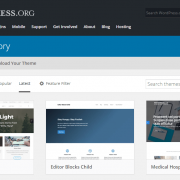Cloudflare: Understanding Content Delivery Networks (CDN)
Content Delivery Networks (CDN) have been around for years, and as long as they’ve been around, there has been some confusion as to what they are and what they do.
In today’s post, we will show exactly how a CDN can help your business by looking into how Cloudflare implemented this technology.
What Is a Content Delivery Network?
A Content Delivery Network, also known as a CDN, is a network of geographically disbursed devices (nodes) which are used to deliver website content more quickly.
Let’s start with the basics.
When a client pulls up your website, they’re making a connection to your server and downloading the content. Their web browser then displays this downloaded content. This process means the client is downloading every word, image, video, everything rendered in their browser.
As you have noticed when trying to load content-heavy web pages, this can quickly get out of hand. What’s worse, is that it can easily cause the dreaded long load times, one of the worst mistakes a site owner can make. This situation is exasperated when a client is hundreds or thousands of miles away.
There are several ways to help combat this, like minimizing your front page or using thumbnails or lower resolution images on content-heavy pages. Another way is to employ a Content Delivery Network.
A CDN’s network of devices, called nodes, are used to cache your content, which puts content being geographically closer to your end user. Because these nodes are located all over the globe, your client’s request has a much shorter distance to travel. This shorter distance makes for quicker load times and a better experience for your user. Hopefully it also fosters more engaged prospects and customers!
How Does a Content Delivery Network Work?
Despite its appearance, the way a CDN functions is pretty straightforward. The process relies on a master/copy relationship, referred to as Origin/node.
Your server is the Origin. It holds all your content for your website. Employing the Cloudflare Content Delivery Network will never change this fact. Once you start using the CDN, its network grabs a copy of your content while it’s en route to customers. A request for your website from a client in, say, Australia is directed to the geographically closest node. If the content is not on that node, the node allows the request to process as usual. The Origin server, hosted on AlpineWeb’s network, receives the request for content. The node then serves that content to the requester, and also caches the content on the node. That means any subsequent requests for that content will be closer to the user. The CDN automatically learns how to best serve your clients wherever they are!
Your content is now half-a-globe closer to your end user, which dramatically speeds up this transaction and lowers your page load time. This can translate into lower bounce rates, more engagement with content, and hopefully more sales!
Due to the Origin/node relationship, your site’s management never changes. You manage your site’s content on your server the same way you always have, so there’s no need to learn a whole new content management interface.
How Does the CDN Know How to Serve My Content?
The request, caching, and delivery of your content rely on DNS. To start using the Content Delivery Network, you have to point your DNS at Cloudflare Name Servers, making them the Authoritative Name Servers for your website’s DNS.
You’ll make this change at your registrar, in the registration configuration portal. Under the Authoritative Nameservers, you’ll state that Cloudflare’s Name Servers are authoritative and so they have the most accurate IP information for that domain name.
If you’ve used AlpineWeb to register and manage your domain name(s), you can do this yourself or one of our Support Staff can manage it for you.
Again, this doesn’t change any aspects of your website or your domain name registration. You’re still using AlpineWeb as your host, and you’ll still be using the same registrar. All you’re doing is announcing to the internet that Cloudflare’s CDN is now the means to request content, not via the Origin directly.
What Kind of Content Is Cached in the nodes?
The Cloudflare Content Delivery Network is configured to cache requests for static content. Static Content is just a fancy way to say content that doesn’t change. All manner of file extensions are cached including images (.gif, .jpg, .ico, .bmp, and more), several types of document files (.pdf, .doc, .docx, .ppt, .pptx) as well as most of your site’s style controllers (.css, .class).
Some of these file types can be pretty weighty, so you can start to see how caching these types of files can help with serving content more quickly and, thereby, speed up your web page load times. If you’re curious, you can review a full list of cached extensions. These are only the extensions cached on the free Cloudflare account type. If you’d like more file types cached, they’re available, but it may require upgrading your account. One of our Sales Team Members can easily help with that or submit a Cloudflare update in the AlpineWeb Customer Backroom.
Are there Any Other Perks of the Service?
Of course! Cloudflare has built an impressive application and has worked hard to protect it from much of the malicious traffic across the internet. That protection is built into the network itself, and because the CDN is part of their network, your website can reap those same benefits.
Even before traffic hits the nodes of the CDN, they’ve started inspecting and reporting. Cloudflare has their network configured to block traffic based on several types of identifiers. Identifiers such as:
- Known malicious IP addresses
- Types of requests that are historically known to cause server issues
- Malicious payloads included with the traffic
- Frequency the client is causing the request matches malicious patterns
These are all dropped at the initiation of the request which helps keep your site safe. These safeguards are in place for every request that comes through, which helps to protect you from probing attacks and crawlers that are looking for a security flaw but allows well known and legitimate traffic and crawlers through.
Cloudflare’s CDN service also offers a free SSL encryption service that keeps your traffic secured and encrypted end-to-end.
The configuration for Cloudflare’s free SSL encryption is pretty simple via their interface. Once accessed, under the “Crypto” menu, you’ll just select the “Flexible” Certificate and select to activate it.
There’s a twenty-four hour waiting period before the SSL is active, but that’s a short period of waiting given the advantages and security you get from using an SSL.
Ready to Start Seeing More Engagement on Your Site?
Handle traffic spikes, reduce load-times and see more engagement for your website with the Cloudflare Content Delivery Network. Try it today or contact our Sales Team to get more information.












